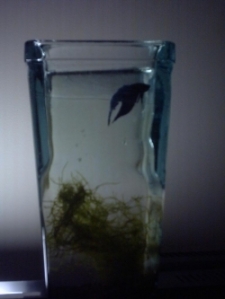Young Photographer Uses her Betta Fish as Inspiration and Model for Mermaid Exhibit
Orangeville’s Lindsay Dewar has her first photography exhibit at Aardvark Music & Culture on Broadway. Five pieces from her Siren Series will be on display at the store for the next few months.
But despite years of creative work, Orangeville’s Lindsay Dewar has never really felt like an artist — until now, that is. And she has her Betta Fish to thank.
The 25-year-old recently landed space at Aardvark Music & Culture (169 Broadway, Orangeville) to exhibit some of her photography for the very first time. Five pieces from her Siren Series will be on display at the store for the next few months.
“It kind of feels like I’m kind of an artist (now),” Dewar said.
The photos are her attempt at portraying mermaids as they were before Disney’s 1989 film, The Little Mermaid, changed people’s perspective on these mythical aquatic creatures with the head and body of a woman and the tail of a fish, she said.
“It’s about originally how mermaids were,” she said. “The series is more of a dark art series. It’s a different perception than most people are used to. … I’ve always been interested in darker story tales and lore and finding beauty wherever you can.”
Dewar’s mermaids are deadly seductresses, not cute and cuddly doe-eyed girls.
Each piece is comprised of several different elements, which Dewar spends hours pulling together.
“It’s like a multimedia piece that’s realistic looking,” she said. “I’m a perfectionist — I have to make sure everything works.”
For one of the pieces in the series, which depicts a mermaid from the back, Dewar had to snap photos of a model, using her betta fish tail and scales, a waterfall as well as taking pictures at an aquarium.
She also incorporated some painting, a statute she’d made of herself and, as with many of her pieces, wrote poetry to explain the image.
“It’s a lot of different layers,” she said. “There were over 50 different elements to pull it together. That one might have taken a week.”
Dewar, who attended both Orangeville District Secondary School and Westside Secondary School, said in high school she was immersed in all sorts of creative pursuits.
“I was into drama, costume design, found art, I was even into video,” she said. “Everything that was artistic I was involved in. The costume designs in my pieces are usually something I’ve created.”
A little more than four years ago, Dewar took an introductory course in photography and discovered she had a knack for taking pictures.
“I kind of found out I had a lot of talent,” she said. “(Before that) I was one of those people who wouldn’t pick up a camera.”
Dewar later enrolled in Sheridan College, where she studied commercial photography. She now works with Tom Partlett at Eclipse Images doing wedding and special event photography.
“I do portraiture as well, but usually with a modern twist,” she said.
Partlett, who has had his work displayed at Aardvark, encouraged Dewar to approach owners Perry Joseph and Gordon Shawcross about displaying some of her pieces at the store, which regularly exhibits the work of local artists.
“For the longest time I was skeptical about putting them up,” she said. “It took five months to come in and show (Joseph) the pieces.”
When she first dropped by the store with her portfolio, Dewar tried to pitch them on displaying some of her other work. But the mermaid series piqued Joseph’s interest.
“She brought in her entire portfolio to the store one day,” Joseph recalls. “There was no question in my mind those were the most interesting (photos). … It’s really beautiful work.”
In fact, they’ve since asked Dewar if she’d be interested in putting together enough pieces for a much larger exhibition in the larger gallery at the rear of the store, he added.
Dewar certainly has lots of pieces to choose from including geishas, Zombies, a vampire series and a pirate series. And she’s not stopping there.
“I’ve got a lot on the horizon,” she said. “I think that being creative with art is a way to make people’s dreams a reality. That’s kind of what I wanted to show with my art.”
To view Dewar’s work, drop by Aardvark, or visit www.lindenphotography.ca.
“Want to know the Betta Facts for keeping your bettas happy, healthy and long-living? I have enjoyed raising healthy, happy bettas for over 20 years, and if you head to this amazing web site for some incredible betta care tips (and a limited time offer with some freebies) I know you will be blown away. See you there!”
Elizabeth Christopher
P.S.
And if you enjoyed the info, don’t forget to share with your friends through the social buttons below!
Let’s save as many Betta Fish as we can, and give them the best lives possible.





 Posted by Elizabeth Christopher
Posted by Elizabeth Christopher 










 Wait til you see the info you get, and 4 free special bonuses. For more info and a time-sensitive special price go to
Wait til you see the info you get, and 4 free special bonuses. For more info and a time-sensitive special price go to